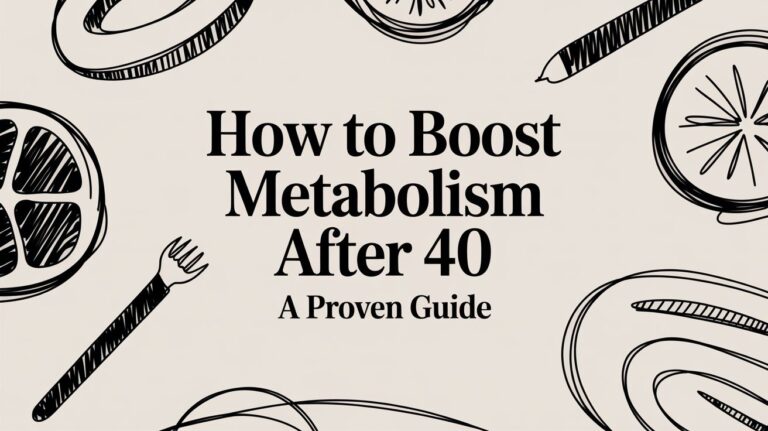8 Effective Weight Loss Plateau Tips for 2025
You’ve been consistent with your diet and exercise, the scale was steadily dropping, and then, seemingly overnight, it stops. This frustrating standstill is a weight loss plateau, a common but maddening experience for anyone on a health journey. It’s not a sign that you've failed or that your efforts are no longer working. Instead, it’s a biological signal that your body has successfully adapted to your current routine, becoming more efficient at using energy.
This adaptation involves a combination of factors. Your metabolism may have slowed slightly in response to your new, lower body weight, and your hormones might have shifted to conserve energy. Even small, unintentional changes in your daily habits, like moving a little less or being less strict with portion sizes, can contribute to stalled progress. A plateau is essentially your body hitting a new equilibrium. To break through, you need to disrupt that balance and create a new stimulus for change.
This comprehensive guide is designed to provide you with a powerful toolkit of actionable weight loss plateau tips that address the root causes of stalled progress. We will move beyond generic advice and delve into specific, evidence-backed strategies that you can implement immediately. You will learn how to:
- Recalculate and adjust your caloric and macronutrient needs for your current body weight.
- Strategically modify your fitness routine to challenge your muscles and metabolism in new ways.
- Optimize lifestyle factors like sleep and stress, which have a profound impact on fat loss hormones.
- Implement advanced techniques like diet breaks and reverse dieting to reset your metabolism.
Each tip is crafted to be a clear, practical solution, helping you diagnose the specific reason for your stall and apply the right fix. It's time to stop feeling stuck and start seeing results again. Let's get the scale moving.
1. Change Your Workout Routine (Periodization & Cross-Training)
One of the most common culprits behind a frustrating weight loss plateau is workout adaptation. Your body is an incredibly efficient machine; when you perform the same exercises repeatedly, it learns to execute those movements using less energy. This efficiency, while impressive, can halt your progress by reducing your overall calorie burn. Introducing strategic variety through periodization and cross-training is a powerful way to break through this stalemate.
This approach forces your body to constantly adapt to new stimuli, reigniting metabolic activity and muscle growth. Instead of letting your body get comfortable, you keep it guessing.
How It Works: Preventing Metabolic Adaptation
When you first start a new workout, your body is inefficient. It burns more calories to perform the unfamiliar movements. Over time, neuromuscular pathways become more efficient, and your muscles adapt to the specific stress you’re placing on them. This is when progress can stall.
By systematically changing your routine's variables-such as intensity, volume, and exercise type-you prevent this adaptation. This forces new muscle fiber recruitment, increases post-exercise oxygen consumption (the "afterburn effect"), and stimulates a fresh metabolic response. It's not just about working harder; it's about working smarter by introducing novel challenges.
Actionable Tips for Implementation
To effectively bust through a plateau, you need to be intentional with your workout changes. Simply doing random exercises isn't enough. Consider these structured approaches:
- Introduce High-Intensity Interval Training (HIIT): If you primarily do steady-state cardio like jogging, swap two or three sessions per week with HIIT. For example, on a stationary bike, alternate between 30 seconds of all-out sprinting and 60 seconds of easy recovery pedaling for 15-20 minutes. This significantly boosts calorie burn in less time.
- Embrace Cross-Training: Dedicate different days to different activities. A week could include two days of strength training, one day of swimming, one HIIT session, and one long-distance run or hike. This method not only challenges different muscle groups but also reduces the risk of overuse injuries.
- Implement Periodization: Structure your training in 4-6 week blocks, each with a different focus. For example, complete a 4-week "hypertrophy" phase (moderate weight, 8-12 reps) to build muscle, followed by a 4-week "strength" phase (heavy weight, 4-6 reps), and then an "endurance" phase (lighter weight, 15-20 reps). This systematic variation is a cornerstone of long-term progress.
- Apply Progressive Overload: Within any training block, always aim to do a little more than last time. This could mean adding 5 pounds to your squat, running a quarter-mile further, or squeezing in one extra repetition. Consistent, measurable progress is key.
2. Recalculate and Adjust Caloric Intake
A common but often overlooked reason for hitting a weight loss plateau is that your body's energy needs have changed. As you lose weight, your Basal Metabolic Rate (BMR) and Total Daily Energy Expenditure (TDEE) naturally decrease. A smaller body simply requires less energy to maintain itself. If you continue consuming the same number of calories you did at a higher weight, your once-effective deficit can shrink or disappear entirely.
This metabolic reality means that the calorie target that initiated your weight loss journey may now be your new maintenance level. Proactively recalculating your needs is one of the most effective weight loss plateau tips to get the scale moving again.

How It Works: Aligning Intake with Your New Body
Your TDEE is the total number of calories your body burns in a day, factoring in your BMR, physical activity, and the thermic effect of food. When you lose a significant amount of weight (typically 10% of your body weight or more), this number drops. For instance, a person who weighed 200 pounds might have had a maintenance TDEE of 2,500 calories. After losing 20 pounds, their new maintenance TDEE might be closer to 2,300 calories.
By failing to adjust for this change, the 500-calorie deficit they were using to lose weight (eating 2,000 calories) has now shrunk to only a 300-calorie deficit, slowing progress considerably. Recalculating your TDEE based on your current weight and adjusting your intake ensures your calorie deficit remains effective for continued fat loss.
Actionable Tips for Implementation
Adjusting your calories requires precision, not drastic cuts. A gradual, informed approach prevents metabolic stress and muscle loss. Use these strategies to make an effective change:
- Re-evaluate Every 10-15 Pounds: Use a reliable online TDEE calculator every time you lose about 10-15 pounds or if your progress stalls for more than three weeks. Input your new weight, age, and current activity level for an updated estimate.
- Make Small, Gradual Reductions: Once you have your new TDEE, reduce your daily intake by just 100-250 calories. A massive drop can trigger a more aggressive metabolic slowdown. For example, if your intake was 1,900 and your new target is 1,750, start by eating 1,800 for a week to see how your body responds.
- Prioritize Protein: When reducing calories, ensure your protein intake remains high (around 0.7-1.0 grams per pound of body weight). Protein is crucial for preserving lean muscle mass during a deficit, which keeps your metabolism running as high as possible. Find ideas for satisfying, high-protein meals by exploring these delicious low-calorie recipes.
- Track Your Intake Diligently: Before making any changes, track your food intake accurately for a week using an app like MyFitnessPal. This provides a clear baseline and ensures you are actually eating what you think you are, helping you make more precise adjustments.
3. Increase Protein Intake
When the scale stops moving, one of the most effective dietary adjustments you can make is to strategically increase your protein intake. Protein is a powerful macronutrient for fat loss due to its metabolic and satiety-boosting properties. Unlike carbohydrates and fats, your body expends significantly more energy to digest, absorb, and process protein, a phenomenon known as the thermic effect of food (TEF).
This simple macronutrient shift can reignite your metabolism and help preserve precious muscle tissue, which is crucial for maintaining a high resting metabolic rate. It's not about eating less; it's about eating smarter to encourage your body to start burning fat again.

How It Works: Boosting Metabolism and Satiety
Protein has the highest TEF of all macronutrients, burning 20-30% of its own calories during digestion. This means that for every 100 calories of protein you consume, your body uses 20-30 of those calories just to process it. This provides a subtle but meaningful boost to your daily energy expenditure, which can be a game-changer during a plateau.
Furthermore, protein is incredibly satiating. It helps regulate hunger hormones like ghrelin, making you feel fuller for longer and reducing the likelihood of overeating or snacking on calorie-dense foods. By preserving lean muscle mass during a calorie deficit, it ensures that the weight you lose is primarily from fat, not muscle.
Actionable Tips for Implementation
Simply deciding to eat more protein isn't enough; you need a clear plan to integrate it effectively into your diet. Consider these actionable strategies to break through your weight loss plateau:
- Set a Clear Target: Aim for 0.7 to 1.0 grams of protein per pound of your target body weight. For a person aiming to weigh 150 lbs, this translates to 105-150 grams of protein per day. This is a common strategy used by fitness professionals to enhance body composition.
- Distribute Intake Evenly: Instead of consuming most of your protein in one large meal, spread it across 4-5 smaller meals or snacks. Aim for 25-30 grams of protein per serving to maximize muscle protein synthesis and keep hunger at bay throughout the day.
- Prioritize Whole Food Sources: Focus on incorporating high-quality, lean protein sources into every meal. Excellent options include chicken breast, fish, lean beef, eggs, Greek yogurt, and legumes. You can explore a comprehensive list of high-protein foods on healthyweighthappylife.com to expand your options.
- Supplement Strategically: Use protein supplements like whey or casein powder to conveniently meet your daily targets. A post-workout shake or a scoop mixed into oatmeal or yogurt can easily add 20-25 grams of protein to your daily total.
4. Incorporate Strength Training or Increase Resistance
A common mistake during weight loss is focusing exclusively on cardio and calorie cutting, which can lead to the loss of metabolically active muscle mass alongside fat. As you lose muscle, your basal metabolic rate (BMR) drops, making it harder to maintain a calorie deficit. Incorporating strength training is one of the most effective weight loss plateau tips because it preserves and builds muscle, keeping your metabolic engine running high.
This strategy shifts the focus from purely scale weight to body composition. Even if the number on the scale stalls, you could be losing fat while gaining lean muscle, resulting in a healthier, stronger, and more toned physique.
How It Works: Protecting Your Metabolic Rate
Lean muscle tissue is more metabolically active than fat tissue; it burns more calories at rest. When you lose weight through diet and cardio alone, up to 25% of that loss can be muscle. This metabolic slowdown is a primary driver of plateaus.
By adding resistance training, you create a stimulus for your muscles to grow or at least be maintained, signaling to your body to preferentially burn fat for energy. This not only counteracts the metabolic dip but can also improve insulin sensitivity and hormonal balance, further supporting fat loss. It effectively turns your body into a more efficient fat-burning machine.
Actionable Tips for Implementation
To properly integrate strength training, you must be strategic and consistent. Randomly lifting weights is less effective than following a structured plan.
- Prioritize Compound Movements: Build your routine around exercises that work multiple muscle groups simultaneously, such as squats, deadlifts, bench presses, and overhead presses. These provide the most metabolic bang for your buck.
- Apply Progressive Overload: This is the key to continuous progress. Each week, aim to slightly increase the challenge, whether it’s adding a small amount of weight, performing one more repetition, or adding an extra set. For example, if you squatted 100 lbs for 8 reps, try for 9 reps the next session.
- Schedule 2-4 Sessions Per Week: Aim for consistency. If you're new, start with two full-body workouts per week. If you're more experienced, three or four sessions targeting different muscle groups might be more effective.
- Fuel Your Muscles: Pair your training with adequate protein intake (around 0.7-1.0 grams per pound of body weight) to support muscle repair and growth. This synergy is crucial for breaking through a plateau.
- Track Your Lifts: Monitor your strength gains separately from your body weight. Seeing your squat or deadlift numbers increase is a powerful indicator of progress, even when the scale isn't moving.
5. Implement Intermittent Fasting or Meal Timing Adjustments
Sometimes, breaking a weight loss plateau isn’t just about what you eat, but when you eat. Altering your meal timing can be a powerful tool to shake up your metabolism, improve hormonal balance, and create a more sustainable calorie deficit. Intermittent fasting (IF) is not a diet in the traditional sense; it's an eating pattern that cycles between periods of eating and voluntary fasting.
This strategy can help you overcome a stall by improving insulin sensitivity, boosting fat-burning hormones like norepinephrine, and making it easier to manage your overall calorie intake. By compressing your eating window, you naturally limit opportunities for mindless snacking and overconsumption.
How It Works: Hormonal Optimization and Calorie Control
A weight loss plateau often involves some level of hormonal resistance, particularly to insulin. When you are in a fasted state, insulin levels drop significantly, which allows your body to more easily access and burn its stored fat for energy. This shift from using glucose to using fat as a primary fuel source is a key mechanism for breaking through a plateau.
Furthermore, intermittent fasting can make calorie restriction feel more manageable. Instead of spreading a limited number of calories over three to six small, often unsatisfying meals, you can enjoy larger, more satisfying meals within your designated eating window. This can improve adherence and reduce feelings of deprivation, which is a common reason people abandon their weight loss efforts.
Actionable Tips for Implementation
Successfully integrating intermittent fasting requires a gradual and mindful approach. Plunging into an extreme fasting schedule can be counterproductive. Consider these structured tips to get started:
- Start with a 12:12 Schedule: Before jumping into more advanced protocols, get your body accustomed to the concept. Simply finish your last meal by 8 p.m. and don't eat again until 8 a.m. the next day. This 12-hour fast is a great entry point.
- Progress to the 16:8 Method: Once you are comfortable, extend your fasting window. The 16:8 method, popularized by Martin Berkhan's Leangains protocol, involves fasting for 16 hours and eating all your meals within an 8-hour window (e.g., 12 p.m. to 8 p.m.).
- Stay Hydrated: During your fasting period, drink plenty of zero-calorie fluids like water, black coffee, or unsweetened tea. This helps manage hunger and keeps you hydrated.
- Break Your Fast Wisely: Avoid breaking your fast with a massive, high-sugar meal. Start with a balanced meal containing protein, healthy fats, and complex carbs to provide sustained energy and prevent a blood sugar spike. Planning these meals is crucial, and a structured meal plan for weight loss on healthyweighthappylife.com can provide the guidance you need.
- Align Fasting with Strength Training: For optimal results, try to schedule your workouts toward the end of your fast or within your eating window to ensure your muscles have the nutrients needed for recovery and growth.
6. Manage Stress and Improve Sleep Quality
It's easy to focus solely on diet and exercise, but invisible forces like chronic stress and poor sleep can silently sabotage your progress and cement a weight loss plateau. Your body's hormonal environment is a powerful regulator of metabolism and fat storage. When stress and sleep deprivation run rampant, they create a cascade of hormonal disruptions that make fat loss significantly more difficult, even with a perfect diet and workout plan.
Tackling these lifestyle factors isn't just about general well-being; it's a direct physiological strategy to reset your body's fat-burning potential and get the scale moving again.
How It Works: Regulating Cortisol and Hunger Hormones
Chronic stress triggers the release of cortisol, a hormone that, in prolonged high levels, can increase appetite (especially for high-calorie foods), encourage abdominal fat storage, and break down muscle tissue. Similarly, a lack of quality sleep wreaks havoc on your hunger hormones. It increases ghrelin (the "I'm hungry" hormone) and decreases leptin (the "I'm full" hormone), creating a perfect storm for overeating and cravings.
By actively managing stress and prioritizing 7-9 hours of quality sleep, you help normalize cortisol levels and restore the natural balance of ghrelin and leptin. This directly improves appetite control, reduces cravings, and allows your body to more effectively access and burn stored fat for energy. It's one of the most effective non-dietary weight loss plateau tips available.
Actionable Tips for Implementation
Integrating stress management and sleep hygiene into your routine requires conscious effort but yields powerful results. Focus on small, consistent changes:
- Prioritize a Consistent Sleep Schedule: Aim for 7-9 hours of sleep per night. Going to bed and waking up at the same time, even on weekends, helps regulate your body's internal clock (circadian rhythm) for deeper, more restorative sleep.
- Optimize Your Sleep Environment: Make your bedroom cool, dark, and quiet. Use blackout curtains, a white noise machine, or earplugs if necessary. This signals to your brain that it's time to rest.
- Establish a Digital Curfew: Avoid screens (phones, tablets, TVs) for at least 30-60 minutes before bed. The blue light emitted can suppress melatonin production, a key hormone for sleep onset.
- Incorporate Daily Stress Reduction: You don't need to spend hours meditating. Start with just 10-15 minutes of a stress-reducing activity each day, such as guided meditation with an app like Calm or Headspace, deep breathing exercises, journaling, or gentle yoga.
- Limit Evening Stimulants: Avoid caffeine after 2 p.m. and limit alcohol in the evening. While alcohol may make you feel drowsy, it disrupts deep sleep cycles later in the night.
7. Track and Manage Hidden Calories (Beverages, Oils, Condiments)
A common reason for hitting a weight loss plateau is a gradual and often unintentional increase in calorie intake from sources we tend to overlook. You might be meticulously planning your main meals, but hidden calories in beverages, cooking oils, dressings, and even "healthy" snacks can quietly sabotage your deficit. Getting serious about tracking everything that passes your lips is a critical diagnostic tool to reveal why the scale has stopped moving.
This meticulous approach often uncovers a "calorie creep" that has eroded your intended deficit, explaining why progress has stalled. It’s not about perfectionism; it's about accuracy to regain control.

How It Works: Closing the Awareness Gap
Even with the best intentions, it's easy to misjudge portion sizes and caloric density. A "drizzle" of olive oil can add 120 calories, a "handful" of nuts can be over 200, and a morning latte can pack as many calories as a small meal. These additions accumulate quickly and can easily turn a 500-calorie deficit into a maintenance-level intake without you realizing it.
By using a food scale and a tracking app, you replace guesswork with data. This process shines a light on the true caloric and macronutrient composition of your diet, providing the clarity needed to make precise adjustments. Discovering that your "healthy" 600-calorie smoothie bowl was thought to be only 300 calories can be the key to breaking your plateau.
Actionable Tips for Implementation
To implement this strategy effectively, commit to a period of diligent, honest tracking for at least one to two weeks. This will provide enough data to identify patterns and make meaningful changes.
- Weigh Everything with a Food Scale: Don't rely on measuring cups for solids. Weigh calorie-dense foods like nuts, grains, cheese, and meats to get an exact measurement. A single tablespoon of peanut butter can vary by 50 calories or more depending on how you scoop it.
- Log All Liquids and Oils: Track every drop. This includes the splash of creamer in your coffee, the tablespoon of oil you cook with, and the weekend glass of wine or beer. Liquid calories are a primary source of hidden intake.
- Account for Condiments and Dressings: That seemingly harmless ranch dressing or mayonnaise can add 100-200 calories to a salad or sandwich. Measure and log these additions to understand their impact.
- Use a Reputable Tracking App: Leverage tools like MyFitnessPal or Cronometer, which have extensive databases. Use the barcode scanning feature for accuracy on packaged foods.
- Review Your Data: After a week of tracking, analyze your daily and weekly reports. Identify where the unexpected calories are coming from and create a strategy to reduce or account for them. This is one of the most effective weight loss plateau tips for regaining momentum.
8. Take a Strategic Diet Break or Reverse Diet
It may sound counterintuitive, but one of the most effective weight loss plateau tips is to temporarily stop dieting. Prolonged periods in a calorie deficit can trigger a process called adaptive thermogenesis, where your body becomes more efficient and your metabolism slows down to conserve energy. A strategic diet break directly combats this adaptation, serving as a crucial reset button for your body and mind.
This approach works by signaling to your body that the "famine" is over. By increasing calories back to maintenance levels for a short period, you can help normalize key metabolic hormones like leptin (which controls hunger) and thyroid hormones, reduce psychological fatigue, and prepare your body for a more effective fat loss phase afterward.
How It Works: Reversing Metabolic Adaptation
When you consistently eat in a calorie deficit, your body adapts. It lowers its resting metabolic rate (RMR), reduces the thermic effect of food (TEF), and decreases non-exercise activity thermogenesis (NEAT). Essentially, your "calories out" side of the equation shrinks, closing the gap with your "calories in" and stalling progress.
A diet break or a gradual reverse diet interrupts this process. By bringing calories back up to your estimated maintenance level, you alleviate the physiological stress of dieting. This can help restore hormonal balance, boost energy for workouts, and most importantly, "rev up" your metabolism, making your subsequent return to a deficit far more productive.
Actionable Tips for Implementation
Properly executing a diet break is key to its success. It's not a free-for-all, but a structured, temporary phase. Consider these expert-backed strategies:
- Implement a Diet Break: For 1-2 weeks, increase your daily calorie intake to your estimated maintenance level. For example, if you've been eating 1,700 calories, and your maintenance is around 2,200, you would eat 2,200 calories daily for this period. A planned break can reignite fat loss once you resume your deficit.
- Try Reverse Dieting: For a more gradual approach, slowly add calories back into your diet over several weeks. Popularized by experts like Dr. Layne Norton, this involves adding 50-100 calories per week until you reach your new, higher maintenance level. This method is excellent for finding your new baseline without significant fat gain.
- Maintain Protein and Training: During your diet break, continue to prioritize high protein intake and keep up your strength training routine. This ensures that any weight you gain is primarily water and glycogen, not body fat, and that you preserve your hard-earned muscle mass.
- Plan Your Return: Before you start your break, decide on the exact date you will return to your calorie deficit. This psychological commitment prevents a temporary break from turning into a permanent abandonment of your goals. Expect a small, temporary weight increase on the scale from water and glycogen-this is normal and will come off quickly.
8-Point Weight-Loss Plateau Strategy Comparison
| Strategy | Complexity 🔄 | Resources ⚡ | Expected outcomes 📊 | Ideal use cases 💡 | Key advantages ⭐ |
|---|---|---|---|---|---|
| Change Your Workout Routine (Periodization & Cross-Training) | Medium — planning and variety required | Moderate — gym/equipment helpful but can be bodyweight | Prevents adaptation, boosts metabolism, improves fitness 📊 | When progress stalls from repetitive workouts or boredom | Prevents plateaus, engages varied muscles, reduces injury risk ⭐ |
| Recalculate and Adjust Caloric Intake | Low–Medium — math and tracking skills needed | Low — scale/apps; nutrition knowledge helpful | Restores deficit appropriate to new weight; resumes fat loss 📊 | Weight loss slowed because intake unchanged after weight loss | Directly addresses metabolic change; simple and evidence-based ⭐ |
| Increase Protein Intake | Low — adjust meals and track protein targets | Low–Moderate — higher food cost, possible supplements | Preserves lean mass, increases satiety, raises TEF modestly 📊 | During calorie deficit or when losing muscle mass | Improves body composition and recovery; reduces hunger ⭐ |
| Incorporate Strength Training / Increase Resistance | Medium — learning form and progressive programming | Moderate — weights or gym access; coaching optional | Increases resting metabolic rate, improves composition and strength 📊 | Cardio-only dieters or those losing muscle during a cut | Builds/preserves muscle, long-term metabolic benefit, non-scale wins ⭐ |
| Implement Intermittent Fasting / Meal Timing Adjustments | Low–Medium — habit change and timing consistency | Low — mostly scheduling; no special gear | May reduce overall intake, improve insulin sensitivity, aid adherence 📊 | People seeking simpler meal windows or improved eating control | Flexible, diet-agnostic, can simplify tracking and reduce intake ⭐ |
| Manage Stress and Improve Sleep Quality | Medium — consistent lifestyle changes required | Low — time; apps or professional help if needed | Better hormonal balance, appetite control, recovery; indirect weight benefits 📊 | Plateaus linked with poor sleep, high stress, or recovery issues | Addresses root causes, improves health and performance ⭐ |
| Track and Manage Hidden Calories (Beverages, Oils, Condiments) | Medium–High — meticulous logging and weighing | Low–Moderate — food scale, tracking apps, time investment | Often reveals 300–500 kcal/day of excess; immediate deficit correction 📊 | Suspected underreported intake or unexplained stalls | Quick identification of problem sources; immediate impact on deficit ⭐ |
| Take a Strategic Diet Break or Reverse Diet | Medium — planned transition and discipline to resume deficit | Low — monitoring and adherence; no special tools | Hormonal/metabolic reset; temporary weight gain then often renewed loss 📊 | Long-term dieters with adaptive thermogenesis and high hunger | Restores hormones, preserves muscle, improves adherence and mental recovery ⭐ |
Turning Your Plateau into a Launchpad
Reaching a weight loss plateau can feel like hitting a wall, a frustrating end to what was once steady progress. However, it's crucial to reframe this experience. A plateau isn't a sign of failure; it’s a biological and physiological signal that your body has adapted to your current routine. This is a checkpoint, not a finish line. The strategies detailed in this guide are your toolkit for recalibrating your approach and turning this stall into a powerful launchpad for your next phase of progress.
Throughout this article, we’ve dismantled the common causes behind stalled weight loss and provided a comprehensive suite of actionable weight loss plateau tips. From the metabolic necessity of recalculating your caloric intake to the muscle-building power of progressive strength training, each tip is designed to address a specific adaptive response your body has made. You've learned that simply "doing more of the same" is rarely the answer.
Key Takeaways: Your Blueprint for Breaking Through
To move forward effectively, let's distill the most critical takeaways. Your body is an incredibly efficient machine, and its goal is homeostasis, or stability. When you lose weight, your Basal Metabolic Rate (BMR) naturally decreases because you have less body mass to maintain. This is a fundamental concept that underscores why adjustments are non-negotiable.
Here’s a summary of your most powerful next steps:
- Audit, Don't Assume: Stop guessing. The first and most critical step is to re-evaluate your actual intake and expenditure. Use a food-tracking app to meticulously log everything for one week, including hidden calories from oils, sauces, and beverages. Simultaneously, reassess your Total Daily Energy Expenditure (TDEE) using an updated calculator with your current weight. This data is the foundation of your new strategy.
- Prioritize Protein and Strength: If you only implement two changes, make them these. Increasing your protein intake to 1.6-2.2 grams per kilogram of body weight will enhance satiety, boost the thermic effect of food, and protect precious muscle mass. Combining this with a dedicated strength training routine that emphasizes progressive overload is the most effective way to counteract metabolic slowdown.
- Embrace Strategic Recovery: Overtraining and chronic stress can be just as detrimental as a poor diet. Prioritizing 7-9 hours of quality sleep and implementing stress-management techniques are not optional luxuries; they are essential for regulating cortisol and hunger hormones like ghrelin and leptin. Sometimes, the best way to push forward is to strategically pull back with a diet break or a reverse diet.
From Information to Lasting Transformation
Mastering these concepts is about more than just restarting the number on the scale. It's about building a deeper understanding of your body’s unique needs and developing a more resilient, sustainable lifestyle. When you learn to diagnose the root cause of a plateau, you equip yourself with the knowledge to navigate future challenges with confidence instead of frustration. You transform from someone who passively follows a plan to an active, informed participant in your own health journey.
This process builds metabolic flexibility and mental fortitude. Celebrating non-scale victories, like lifting heavier weights, having more energy, or clothes fitting better, becomes a crucial part of recognizing your success. Remember, consistency will always trump perfection. Choose one or two of these weight loss plateau tips to implement this week. Track your response, be patient, and adjust as needed. This methodical, informed approach is the key to creating results that last a lifetime. View this moment not as a setback, but as an advanced course in your personal health education. You've got this.
Ready to give your efforts an extra, science-backed boost? The precision-formulated supplements and meal replacements from Healthy Weight Happy Life are designed to provide the targeted nutritional support that can make all the difference when breaking through a plateau. Explore our solutions at Healthy Weight Happy Life and discover how to optimize your nutrition and accelerate your results.
Article created using Outrank







